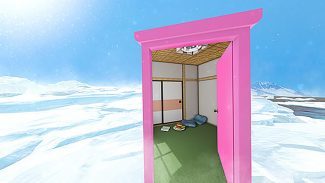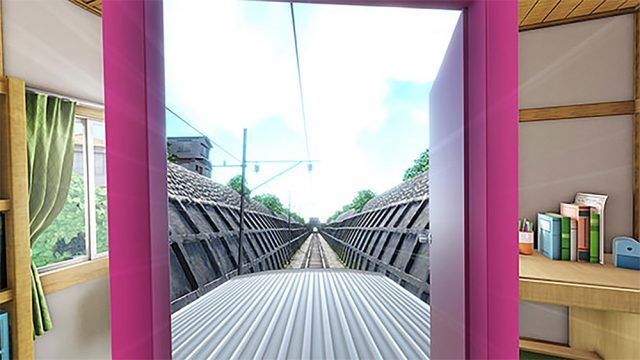‘Doraemon’ is a popular manga and anime involving a robotic cat who travels back in time to help a young boy. Among Doraemon’s many tricks from the future is the ‘Anywhere Door’ which can be opened to transport people… well, anywhere. A VR take on this idea uses simple props to make a unique VR experience.
Bandai Namco’s ‘Project i Can‘ has made the Anywhere Door a (virtual) reality using the HTC Vive, Leap Motion, and a few simple props tracked with attached Vive controllers. The result is a compelling experience that turns the ordinary into the extraordinary. In the video heading this article you can get a glimpse of the Doraemon Anywhere Door experience which saw recent installations in out-of-home VR locations in Japan.
 The experience makes use of a real door and a desk. Both real life props are aligned with their virtual counterparts and serve initially to anchor the user in a rather mundane virtual room. But then the users are asked to open the door—which they do by physically reaching out and opening the real door—which reveals a portal into an entirely different space: a vast arctic environment filled with icebergs and ocean. As users step through the door frame they enter into that environment but can still see the room through the doorway behind them.
The experience makes use of a real door and a desk. Both real life props are aligned with their virtual counterparts and serve initially to anchor the user in a rather mundane virtual room. But then the users are asked to open the door—which they do by physically reaching out and opening the real door—which reveals a portal into an entirely different space: a vast arctic environment filled with icebergs and ocean. As users step through the door frame they enter into that environment but can still see the room through the doorway behind them.
The Leap Motion hand-tracking sensor is used not only to let the users see their hands in VR—making it easier for them to grab the doorknob with their own hands—but also frees up the spare Vive controllers to be used as simple motion trackers to align the opening of the real door with the virtual door (and later the desk drawer too).
As users walk forward into the arctic space and onto the iceberg, the ice around them crumbles, which serves not only for a little scare, but also smartly keeps them from bumping into the boundary of their tracked space (which would otherwise break the illusion of the vast area before them).
As users walk back through the door and into the room, they can look on the other side of the door and see through it as if it’s just an empty door frame. The combination of the ‘real’ door prop and it’s ‘impossible’ virtual abilities makes for deep immersion.
 Another scene seen through the door puts the users on top of a train with a tunnel rushing right at them. As the tunnel nears, it becomes apparent that the users are on a collision course, though they can be saved by ducking.
Another scene seen through the door puts the users on top of a train with a tunnel rushing right at them. As the tunnel nears, it becomes apparent that the users are on a collision course, though they can be saved by ducking.
The same real/virtual prop technique is used for the nearby desk, which has a drawer that, when opened, reveals a portal into a space that’s deeper than the drawer itself could possibly be. Smartly, the draw bottom has been removed, which allows the users to reach ‘through’ the bottom of the drawer, selling the illusion of impossible physical geometry.
The mix of real props and virtual reality is taken to the extreme at places like The VOID, but the Doraemon Anywhere Door experience shows that similar techniques can be applied even in a limited room-scale space with little more than some simple props and a heap of creative thinking.






